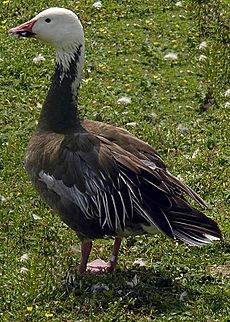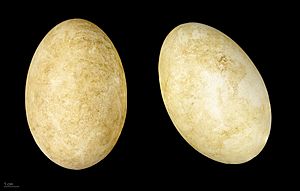Snow goose facts for kids
Quick facts for kids Snow goose |
|
|---|---|
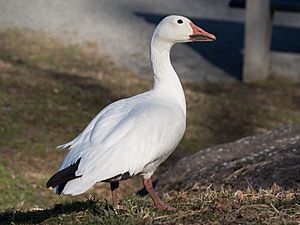 |
|
| A. caerulescens white morph | |
| Conservation status | |
| Scientific classification | |
| Genus: |
Anser
|
| Species: |
caerulescens
|
| Subspecies | |
|
|
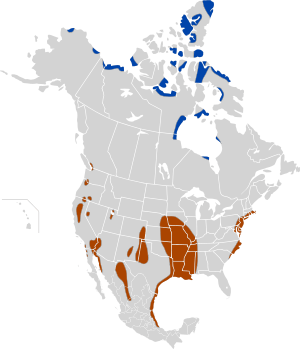 |
|
| Snow goose range: Breeding range Wintering range | |
| Synonyms | |
|
|
The snow goose (Anser caerulescens) is a type of goose found in North America. It gets its name because most of these birds are white, like snow! Some people call them "white geese" or "light geese."
Snow geese live in very cold places during the summer. They breed in Greenland, Canada, Alaska, and a small part of Siberia. When winter comes, they fly south to warmer parts of North America, like the United States and Mexico. They travel thousands of miles to find food and escape the cold. Sometimes, a few snow geese might fly to Europe, but this is rare.
Contents
What Do Snow Geese Look Like?
Snow geese come in two main colors, called "morphs." There's a white morph, which is mostly white with black tips on its wings. Then there's a dark or "blue" morph. These geese have bluish-gray feathers instead of white, except for their head, neck, and tail. Young blue morph geese are usually dull gray.
Both white and blue snow geese have rose-red feet and legs. Their bills are pink with black edges, which looks like a black "grin patch." Young birds have less bright colors on their feet, legs, and bills. Sometimes, their heads can look rusty-brown from minerals in the soil where they eat. Snow geese are very loud and you can often hear them from far away!
White and blue snow geese can have babies together. Their chicks can be either white or blue. Scientists used to think these two colors were different species. But since they can interbreed, we now know they are just different color phases of the same species. The dark color is controlled by a strong gene, while the white color needs two copies of a weaker gene. Young geese often choose a mate that looks like their parents.
There are two types of snow geese based on their size and where they live. The smaller one is called the lesser snow goose. It lives in central northern Canada and near the Bering Strait. It stands about 64 to 79 centimeters (25 to 31 inches) tall and weighs 2.05 to 2.7 kilograms (4.5 to 6 pounds).
The larger one is the greater snow goose. It nests in northeastern Canada. It usually weighs about 3.2 kilograms (7 pounds) and is about 79 centimeters (31 inches) tall. Some can weigh up to 4.5 kilograms (10 pounds). Both types of snow geese have a wingspan of 135 to 165 centimeters (53 to 65 inches). Blue morphs are not common among greater snow geese.
Snow Goose Life Cycle
Snow geese usually find a partner when they are two years old. However, they don't usually start having babies until they are three years old. Female geese like to return to the exact place where they were born to build their own nests.
Snow geese often nest together in large groups called colonies. They start nesting in late May or early June, depending on how much snow is still on the ground. The female chooses a spot on high ground and builds a shallow nest. She uses plants to line the nest and might use the same nest year after year.
After the female lays her first egg (they usually lay three to five eggs), she adds soft down feathers to the nest. She sits on the eggs for 22 to 25 days to keep them warm. Once the chicks hatch, they leave the nest within a few hours!
The young geese find their own food, but both parents protect them. After 42 to 50 days, the young geese can fly. They stay with their family until they are two or three years old. Sometimes, snow geese and Ross's geese breed together and have mixed babies.
Amazing Migrations
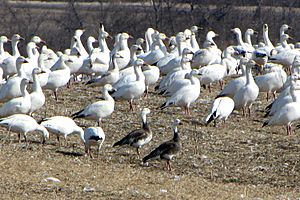
Snow geese breed from late May to mid-August. But they spend more than half the year flying to and from their warmer winter homes. During their spring migration, huge groups of snow geese fly very high. They travel along specific paths, flying over 3,000 miles (4,800 kilometers) from their winter areas to the Arctic tundra.
The lesser snow goose flies through the middle and western parts of North America. They cross prairies and farmlands to reach their wintering grounds in the United States and Mexico. The greater snow goose, which is less common, flies along the eastern coast of North America.
Snow geese used to spend winters in marshy areas, digging up plant roots for food. But now, they also go to farm fields to eat leftover grains. This change might have helped their population grow very large. In 2015, about 2,000 snow geese died in Idaho from a disease during their spring migration.
Snow Goose Habits and Environment
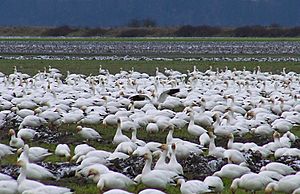
When it's not nesting season, snow geese usually feed in large groups. In winter, they eat leftover grains in farm fields. They travel in huge flocks, often stopping at the same places each year. Snow geese often feed with greater white-fronted geese. However, they tend to avoid feeding with Canada geese, which are usually heavier birds.
The number of greater snow geese was low in the early 1900s, but now their population is healthy. The number of snow geese in North America has grown so much that their breeding areas in the Arctic and their winter feeding grounds are being damaged. This affects other animals that share the same habitats.
Arctic foxes and skuas are common predators of snow goose nests. The eggs and young chicks are most at risk during the first few weeks after they hatch. Adult geese are usually safe. Snow geese sometimes nest near snowy owls. Scientists think the owls help keep other predators away from the goose nests.
Other animals that eat snow goose eggs and chicks include wolves, coyotes, and all three types of North American bears. Outside of nesting season, few animals hunt adult snow geese. But bald eagles (and possibly golden eagles) will attack geese in winter.
Snow Goose Population
The number of lesser snow geese that breed is now more than 5 million birds. This is a huge increase of over 300% since the mid-1970s! Their population is growing by more than five percent each year. This number doesn't even include young geese or adults that didn't nest successfully, so the total number is likely even higher.
The number of lesser snow geese is the highest it has ever been since records started. Large groups of geese are even spreading to new areas along the Hudson Bay coastline. This overpopulation might be because a lot of forest and prairie land was turned into farms in the 1900s.
Since the late 1990s, people in the U.S. and Canada have been trying to reduce the number of lesser snow and Ross's geese. This is because they are damaging the tundra and other nesting areas. New rules were put in place to allow more hunting of these geese. Hunters can take more birds, hunting seasons are longer, and new hunting methods are allowed. However, these efforts have not yet reduced the total number of snow geese in North America.
Gallery
Related pages
Images for kids
See also
 In Spanish: Ánsar nival para niños
In Spanish: Ánsar nival para niños



